City College Pledges Two Free Years for S.B. Grads
The SBCC Promise Looks to Repair Rifts in Community Relations
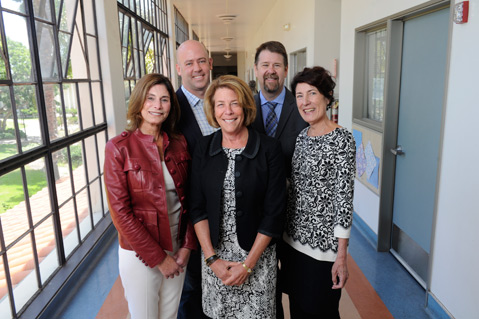
When Geoff Green took over the helm at Santa Barbara City College Foundation 15 months ago, he had a handful of priorities at the top of his to-do list. The first few — balancing the budget and modernizing operations — presented challenges of the nose-to-the-grindstone variety. The big one, however, required a lot more intellectual creativity and salesmanship, with no promise of success: He set out to expand the foundation’s donor base. To succeed, Green would need to regalvanize SBCC’s relationship to greater Santa Barbara.
Plagued by budgetary woes and a critical lack of student housing, the college’s century-old connection to surrounding neighborhoods and beyond had become strained in recent years, presenting a deeply layered puzzle daunting even to Green, the preeminent advocate and grassroots fundraiser who had previously headed up the Fund for Santa Barbara for 12 years. But that was then. These days, it looks like he’s really onto something.
He calls it the SBCC Promise. Starting this fall, any student who completes his or her secondary education, earning a high school diploma or its equivalent, within the college’s district, which stretches along the South Coast from Gaviota to Rincon, can attend SBCC full-time for two years without having to pay for tuition, fees, books, or supplies. There’s no catch. Rich or poor, brown or white, homeschooled homebody or private-school valedictorian — they’re all eligible for the Promise.
“Santa Barbara’s Promise seems really geared toward eliminating any barrier to long-term academic success,” said Martha Parham, senior vice president of public relations at the American Association of Community Colleges in Washington, D.C. “We know that full-time students have better performance and completion rates, so these types of programs provide pathways to opportunities that many students do not currently have.”
The Promise comes with a few conditions. First up, the student must enroll within 12 months of obtaining a high school diploma or its equivalent or upon discharge from military service (if he or she enlisted straight out of high school) and take at least 12 units per semester. Students will also need to establish and follow a two-year Student Educational Plan, which includes, for example, checking off general-ed prerequisites before transferring to a four-year university or securing a two-year associate of arts degree. For help on that front, students must periodically check in with an academic counselor. While the Promise does not require a minimum grade-point average to qualify, once a student is enrolled, SBCC’s longstanding GPA probationary standards will apply. Secondary education documents will be used to verify a student’s geographic eligibility. The Promise will also offer free summer school, with no unit minimum.
As Green hopes to inspire kids who wouldn’t normally chase a college degree, he also suspects that the program will motivate part-time students to go full-time and push full-time students to wrap up their SBCC studies within two years.
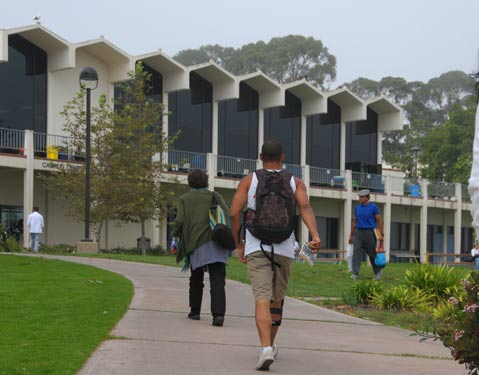
SHOW ME THE MONEY
Historically, California community colleges charged no tuition or fees. Things changed in 1978 with Proposition 13, which put a cap on property taxes, the main source of school funding. By 1984, such budget limitations resulted in mandatory enrollment fees for community college students. At the same time — in an attempt to continue the community college system’s tradition of open access — the legislature waived those fees for financially needy students through a program called the Board of Governors (BOG) Fee Waiver. Today at SBCC, about two-thirds of new enrollments annually utilize these BOG waivers, as they’re called, mirroring the statewide average.
“When compared with other states, California has been pretty good when it comes to supporting community colleges with relatively low tuition and with BOG waivers,” Green explained. “But it’s all focused on tuition, which is typically only 20 percent of the financial burden a student faces. We’re tackling the other 80 percent,” specifically books and supplies.
The climbing cost of textbooks — and their rapid obsolescence — has long been a point of contention for students and faculty alike. At a recent SBCC Board of Trustees meeting, Marilynn Spaventa, SBCC’s interim executive vice president of educational programs, mentioned that some students don’t buy textbooks they can’t afford — especially in math and science — and soon fall behind in class. She added that many teachers are exploring open-source course material and negotiating with publishers for better pricing. Class supplies can be another sizable expense. At SBCC’s School of Culinary Arts, for example, new students need to show up with a chef’s knife and uniform, a one-time cost that can run upward of $900.
Accounting for estimated enrollment, BOG waivers, supplies, and the moving target of textbook costs, Green has estimated that when it’s fully up and running, the SBCC Promise will cost $1.8 million annually. “We’ll have the ability to truly offer two full years for students to study whatever they want and leave without debt,” he said.
The goal by 2020 is to establish a $30 million endowment, no small chunk of change.
“If this was funded by a tax or a bond, people would certainly challenge it,” Green added. “But this is money coming from private donors and foundations that are choosing to support this effort because they recognize how transformative it will be.” As of May 3, the foundation had $1.4 million in commitments for the Promise.
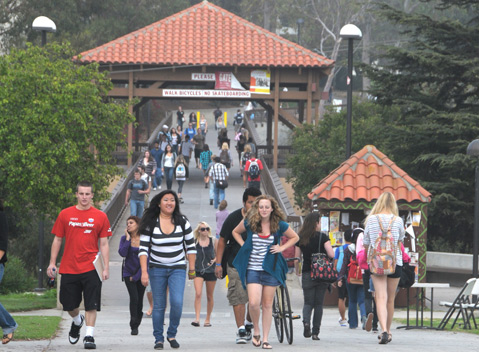
STRAIGHT FROM THE TOP
When Green came aboard as the foundation’s chief executive officer in February of 2015, still fresh in his ears was President Barack Obama’s unveiling of an ambitious and expensive educational proposal dubbed America’s College Promise. The president proposed two years of tuition-free community college “for students willing to work for it,” meaning they had to maintain good grades while chasing a specific goal, such as earning a vocational certificate or making headway toward a university diploma.
Green was also moved by actor Tom Hanks’s opinion piece “I Owe It All to Community College,” which the New York Times published five days after Obama’s proposal. Hanks attended Chabot College, in Hayward, right up the road from Green’s hometown in the Bay Area.
By summer’s end, Obama’s proposal had become America’s College Promise Act of 2015, envisioning a 10-year, $80 billion federal investment. As Green made the rounds that fall to various conferences statewide and beyond, talk of the College Promise kept coming up, he remembers, not to mention ongoing lamentations about the nation’s $1.2 trillion in mounting student debt.
Considering Washington’s political climate, it’s not surprising that Obama’s Promise crashed into congressional obstruction. Regardless, the idea gathered momentum, Green said. “He’s the president; he still has a platform.” (In an update on April 25, the administration proposed tax credits for businesses that donate knowledge, manpower, and equipment to their community colleges, and for hiring recent graduates.)
Green explored what a College Promise could look like for SBCC and how much it might cost. For months, he did his homework, gathered feedback, and asked trusted peers to punch holes in it.
Fortunately, he had nearby baselines to work off of. Since 2006, the Ventura College Promise has provided a year of free tuition, funded in large part by vendor fees collected by Ventura College Foundation’s swap meet, held on campus each weekend. Up in San Luis Obispo, Cuesta College also has a one-year-free program, made possible by an $8.5 million endowment from the Charles and Leeta Dovica Family Trust in 2014.
For a much deeper perspective, Green points to Michigan, where, since a private endowment in 2005, the Kalamazoo Promise has covered tuition to any public college or university in the state for kids who’ve started in the Kalamazoo Public Schools district as kindergarteners, and sliding-scale coverage for students who enter in later grades.
“Kalamazoo was the first to attempt to remove financial barriers for an entire region’s students using privately raised funds,” Green said. “With an approach like that, rather than two or five or 10 scholarships, you create a structural solution. Ultimately, this changes how an entire community views the prospect of attending college. That’s the key.”
Added Madeleine Jacobson, the foundation’s board president, “Our College Promise has been well-received by our donors because it’s so tangible: We’re saying we’ll send our high school seniors to college for free.”
As he crunched the numbers, Green grew more confident. “I knew that it was doable, and I knew it would build another important bridge between the college and the community.”
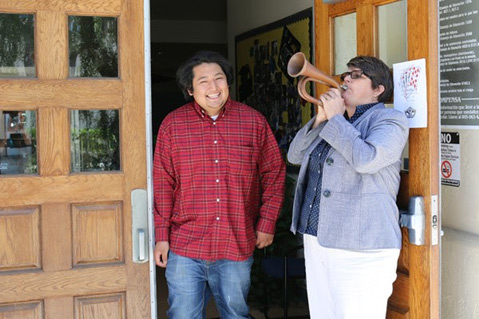
ON THE MEND
SBCC has long enjoyed prestige as a top-tier institution nationally, and its place in the hands of the community was assured by president Peter MacDougall, widely considered charismatic and vastly effective during his two decades of service. Not long after MacDougall’s 2002 retirement, however, the college’s relationship to the surrounding Mesa neighborhood and the city beyond grew strained, and today it’s still weighed down by the emotional baggage of a few rough patches.
Rewind seven or eight years. As the Great Recession made a crisis of California’s education budget, Andreea Serban, SBCC’s president at the time, made a lot of enemies when she hacked away at the college’s beloved Adult Education programming. These were affordably priced classes in the realm of lifelong learning — anything from pottery and jewelry making to parent-child workshops and music lessons. Serban’s administration also added fees to Continuing Education classes that had always been free. Regardless of the money mess Serban had stepped into when she took the helm in the summer of 2008, the cuts and hikes prompted voters — who widely felt ignored as SBCC decided what to cut and by how much — to replace four seats on the seven-member SBCC Board of Trustees. In the summer of 2011, the new board majority showed Serban the door.
Longtime and well-regarded SBCC executive vice president Jack Friedlander covered in the interim — as the budget crisis continued chipping away at the college’s offerings — before current president Lori Gaskin stepped in a year later. While the community was still seeing red from all those cuts, another open sore started to fester. In a constantly tightening market, hundreds of out-of-town SBCC students — many of them from outside the country — had been competing for housing downtown and in Isla Vista. There was also the perception that foreign students were filling up classroom seats that ought to have gone to born-and-raised Santa Barbarans, though the college has maintained an 8 percent cap on international student enrollment since 2009.
“I agree that this institution ignored town/gown issues in the past,” Gaskin said recently, referring to relations between the city and campus. “Certainly, we’ve had our fair share of challenges.”
She also feels deeply that SBCC “is beloved by the community. I believe we’re seen as an institution of first choice. This place can be a life changer.”
It’s tough to argue against SBCC’s academics, confirmed under Gaskin’s watch with the 2013 Aspen Prize for Community College Excellence. That year, SBCC tied with Washington State’s Walla Walla Community College as the best community college in the nation. Off campus, however, things appeared less rosy, as the community’s perception partially blamed out-of-town SBCC students for problems linked to everything from late-night neighborhood noise to Isla Vista’s Deltopia riot in April 2014. And a month later, it certainly didn’t help that mass murderer Elliot Rodger was an SBCC dropout living in Isla Vista.
Six months after that, community colleges statewide were hitting up voters to approve bond measures for campus improvements as the economy slowly recovered from its recessionary coma. The timing seemed right for Measure S, SBCC’s $288 million bond measure for upgrades and new facilities. Long story short: Voters shot it down. (To be fair, $288 million was a fairly big ask, and regardless of low voter turnout during that November 2014 election, Measure S did receive a fraction more than 50 percent in favor, though it needed 55 percent to pass.)
The defeat of Measure S hit Gaskin hard. Before and since, however, she can speak to the institution’s efforts off campus, from teaming up with the District Attorney’s Office and UCSB (among other agencies) on the I.V. Safe campaign, formed after that 2014 Deltopia disaster, to the Student Neighborhood Assistance Program (SNAP), addressing noise complaints against unruly students. Earlier this year, SBCC’s Board of Trustees voted not to extend the college’s contract with Kaplan International English to lease space on campus.
“[Gaskin] has done everything in her power to right the ship, to change [SBCC] back into a resource by and for the community,” said boardmember Dr. Peter Haslund. “We’re sad to see her go.”
After 35 years in administration at the community college level, Gaskin is set for retirement this summer. Her replacement, Dr. Anthony Beebe, president of San Diego City College, was announced by the SBCC Board of Trustees on May 3.
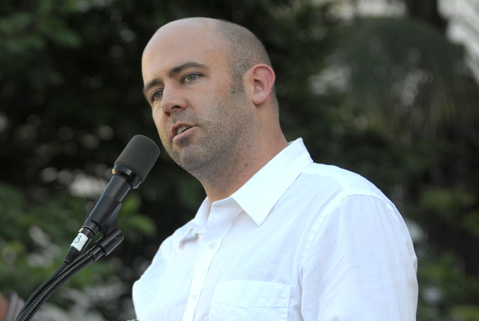
RIGHT GUY, RIGHT PLACE, RIGHT TIME
By several accounts, one of Gaskin’s best moves of late was to convince Green to apply for CEO of the Santa Barbara City College Foundation.
“While the foundation can’t control the message of the college, we like to be in sync,” said Jacobson, the foundation’s board president. “[Green] has worked really hard to be part of the conversations going on in the community related to the college.”
“I had seen him in his leadership capacity and thought he had a sensitivity to our mission as an institution that fosters opportunity for all,” Gaskin said. “That’s important to me. And I think the group that we’re targeting [with the Promise] is one where college-going just wasn’t in their future, for whatever reason.”
The SBCC Promise, like the growing number of Promise programs around the country, reflects the community in which it exists, providing for a manageable number of students across all walks, and funded by a town full of generous donors.
“While Obama’s Promise is working through policy issues, we’re on the ground with foundations, businesses, and private philanthropists looking at how resources can be available to students now,” said Parham, with the American Association of Community Colleges. “And we can see the needle move. I think it’s working. We have more than 125 active College Promise programs, with news of more every day.”
Added Green, “The College Promise movement is pretty massive right now, and we’re riding the crest of it.”
Click here for more information.



